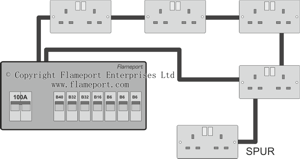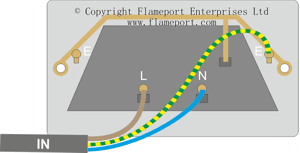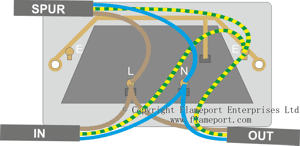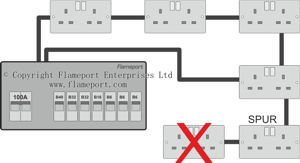Ring Circuits - Adding a socket outlet (1)
There are three ways of adding a socket outlet to a ring circuit. The most common is to connect it as a spur, and this can be done in two ways. Alternatively, the ring can be extended.
Spur from existing socket outlet
 A single cable is added from the new socket, and connects to an existing socket on the ring.
A single cable is added from the new socket, and connects to an existing socket on the ring.
A spur can alternatively be connected at the consumer unit, which although might seem incorrect, is actually no different to connecting to an existing socket outlet.
Socket outlet wiring

 The spur socket only has a single cable, with the connections to Live, Neutral and Earth. This is exactly the same as connecting at the end of a radial circuit. The other end of the cable connects to a socket on the ring, so there will be three cables in that socket.
The spur socket only has a single cable, with the connections to Live, Neutral and Earth. This is exactly the same as connecting at the end of a radial circuit. The other end of the cable connects to a socket on the ring, so there will be three cables in that socket.
In the diagram here, In and Out are the existing ring cables, and Spur is the new cable leading to the new socket outlet.
As before, Brown is Live, Blue is Neutral and the Earth wire is bare copper with a green/yellow sleeve. Make sure that all three wires are secured in each terminal, and avoid damaging the wires when replacing the socket.
Spur Limitations
 Only one socket outlet can be connected to a spur. (This can be a single or double outlet). Connecting a further outlet is NOT permitted, as this could overload the single cable supplying it.
Only one socket outlet can be connected to a spur. (This can be a single or double outlet). Connecting a further outlet is NOT permitted, as this could overload the single cable supplying it.
Each socket outlet or junction box on the ring can only have one spur connected. Trying to connect two or more is not only very difficult due to the number of wires involved, it can also result in an abnormally high load at that point in the ring.
The number of spurs on the ring must not exceed the number of other socket outlets. If for some reason you need a large number of spurs, it is time to replace the whole circuit rather than keep adding to it.


